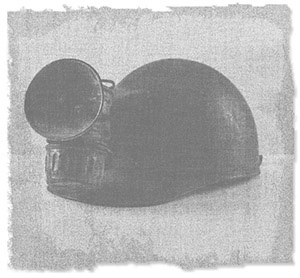
Miners: Beware
CLINTON HARRIS WASN’T even supposed to be there. The shift’s scheduled skip-tender was sick, and Harris had agreed to fill in. He couldn’t afford to turn down the extra hours. So on this fifth day of February, 1924, he found himself at the bottom level of the Milford Manganese Mine’s 200-foot shaft, just north of Crosby in central Minnesota. Harris operated the skip that hoisted ore out of the mine carts and dumped it into a bucket, where it was lifted to the surface. He never could have guessed that on this frigid winter afternoon tragedy was about to strike.
In recent months, despite the danger, the bottom level of the shaft had been dug closer and closer to neighboring Foley Lake; the manganese supply seemed richest there. Many miners sensed the impending danger and quit. Those who stayed learned their fateful mistake at 3:25 p.m. on that disastrous day—when the bottom level collapsed.
The cave-in unleashed a gust of wind so strong that it knocked out the electric lights throughout the mine, plunging the entire underground structure into darkness. This was only the beginning of the trouble, though. Above the shaft, a bog near Foley Lake suddenly broke through, flooding the mine in minutes. Many men at the bottom shaft were killed instantly, as the water pressure drove them into the walls with the force of a car wreck. Harris survived this first wave of danger, and in the moments when he initially recognized the crisis, he had an opportunity to escape. Heroically, he chose to stay behind to help his coworkers.
“We need to get out of here,” another miner yelled. “Run for it!”
“I can’t leave,” Harris answered. “Someone has to warn the others.” He hurried to the warning whistle and pulled. The high-pitched squeal wailed from above the mine, signaling trouble to the workers below.
The water level quickly rose around Harris, and he knew his demise was just seconds away. To ensure that his fellow miners received the signal even after his death, he tied himself to the whistle’s pull string.
It was a noble sacrifice, but Harris couldn’t have guessed that Milford Mine would flood so quickly. Only seven of the 48 men working escaped with their lives. The other 41 miners were trapped and killed in a mixture of mud and freezing water.
In the aftermath of what was to be the Iron Range’s worst mining disaster on record, crews worked for nine months to retrieve the victims’ bodies. But shortly thereafter, the mine was cleaned out and stabilized enough to reopen. Surprisingly, even this terrible disaster wouldn’t deter Minnesota’s crop of hardworking miners. Many men signed on to work, and Milford Mine was once again up and running.
The first to enter found their work environment almost unbearable. They were greeted by the stench of death and decay. That, however, was nothing compared to what the men saw.
They descended into the darkness of the 200-foot shaft, stifling their gags. As they neared the bottom level, their lamp light caught movement below.
“Hold it,” said one of the men. “There might be something down there.”
They all stopped and shone their lights downward. Their lamps revealed a most unexpected horror: the decomposed, barely recognizable figure of Clinton Harris! His apparition clung to the ladder, peering up at them (although his eye sockets were empty), toward the surface he never reached. The whistle cord hung from his waist.
Suddenly, to the men’s continued terror, the mine’s old whistle screamed to life, an ominous warning for the workers to leave—one made even more frightful by the fact that the whistle had been removed earlier, as had Harris’s body.
No less than twelve miners bore witness to that supernatural sighting. All of them retreated out of the shaft at once, and none ever dared to re-enter Milford Mine. As for Harris’s ghost, it must have been satisfied that its message was received. The specter was neither seen nor heard from again.